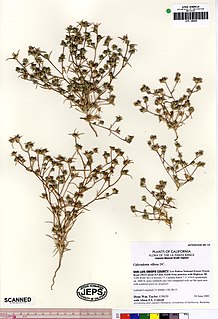
Calycadenia is a genus of flowering plants in the family Asteraceae, known commonly as the western rosinweeds. They are native to California, especially around the Central Valley. The ranges of two species (C. fremontii + C. truncata) do extend north into Oregon.

Erigeron pygmaeus is a species of flowering plant in the family Asteraceae known by the common name pygmy fleabane, or pygmy daisy.
Holozonia is a North American genus of flowering plants in the family Asteraceae. It contains only one known species Holozonia filipes, which is known by the common name whitecrown. It is endemic to California.
Hulsea nana is a North American species of flowering plant in the family Asteraceae known by the common name dwarf alpinegold. It is native to the western United States from Washington, Oregon, and far northern California.

Arnica fulgens is a species of arnica known by the common names foothill arnica and hillside arnica. It is native to western North America, from British Columbia east to Saskatchewan and south as far as Inyo County, California, and McKinley County, New Mexico. It grows in open, grassy areas.

Arnica sororia is a North American species of flowering plant known by the common name twin arnica. It is native to Western Canada and the Western United States. It grows in grasslands and in conifer forests, as well as the sagebrush steppe.
Arnica spathulata is a rare North American species of flowering plant in the family Asteraceae, known by the common name Klamath arnica. It is native to the Klamath Mountains of northwestern California and southwestern Oregon. It grows in woodland habitat, almost exclusively on serpentine soils.
Eucephalus breweri is a North American species in the family Asteraceae known by the common name Brewer's aster. It is native to California where it grows primarily in the Sierra Nevada at subalpine elevations. Its range extends into northwestern Nevada and southwestern Oregon.

Blepharizonia plumosa is a California species of tarweed known by the common name big tarweed. It is endemic to central California, where it grows in the Central Coast Ranges and adjacent sections of the southern San Francisco Bay Area and Central Valley, from southern Sonoma County south as far as San Luis Obispo County.
Calycadenia fremontii is a species of flowering plant in the daisy family known by the common name Frémont's western rosinweed. It is native to southwestern Oregon and northern California. It is a common member of the flora in several types of habitat in the mountains, foothills, and valleys. This annual plant is variable in appearance.
Calycadenia hooveri is a California species of flowering plant in the family Asteraceae known by the common name Hoover's western rosinweed. It is endemic to a short portion of the western Sierra Nevada foothills, where it grows in rocky areas in the hills along from Amador County to Madera County.
Calycadenia mollis is a species of flowering plant in the family Asteraceae known by the common name soft western rosinweed. It is native to a section of central California, from Tuolumne County do northern Tulare County. There are also isolated populations farther north in Nevada County. The plant grows in a number of habitat types in the Central Valley and adjacent Sierra Nevada foothills.

Calycadenia multiglandulosa is a species of flowering plant in the family Asteraceae, known by the common names sticky calycadenia and sticky western rosinweed. It is endemic to California, where it is a common in the Coast Ranges and in the Sierra Nevada Foothills from Shasta County to Kern County.
Calycadenia oppositifolia is a species of flowering plant in the family Asteraceae known by the common name Butte County western rosinweed. It is native primarily to Butte County, California, although a few populations have been found in other parts of the state. It grows in the foothills of the high mountain ranges.
Calycadenia pauciflora is a species of flowering plant in the family Asteraceae known by the common name smallflower western rosinweed. It is endemic to northern California, where it grows in the Coast Ranges north of the San Francisco Bay Area from Napa County to Tehama County.
Calycadenia truncata is a species of flowering plant in the family Asteraceae known by the common name Oregon western rosinweed. It is native to southwestern Oregon and northern and central California. It is found in the Cascades, the Coast Ranges, and the foothills of the Sierra Nevada as far south as Monterey and Tulare Counties.

Calycadenia villosa is an uncommon species of flowering plant in the family Asteraceae known by the common name dwarf western rosinweed. It is endemic to central California, where it is known from a limited distribution in the Central Coast Ranges in Monterey County and San Luis Obispo County, with a few populations in Santa Barbara and western Fresno Counties. There are perhaps 16 occurrences.
Crepis bakeri is a species of flowering plant in the daisy family known by the common name Baker's hawksbeard. It is native to the western United States where it grows in many types of mountain and plateau habitat. It is found in Oregon, Washington, Idaho, northern California, Nevada, and Utah.
Jensia rammii is a species of flowering plant in the family Asteraceae known by the common name Ramm's madia. It is endemic to California, where it is limited to the northern slopes of the Sierra Nevada and its foothills.

Osmadenia is a genus of flowering plants in the family Asteraceae. It contains the single species Osmadenia tenella, which is known by the common name false rosinweed.







